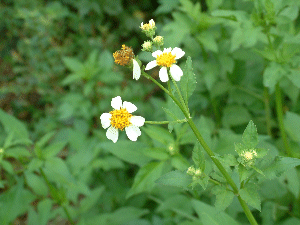


IMPORTANT: The information provided is for information only. The medical claims or advice are not endorsed. Never take any medicines without first consulting a qualified practitioner.

Spanish needles is well-known as a medicinal herb in the Caribbean, as well as in South America and parts of Africa. In Jamaica, they make a tea from the leaves (or the flowers soaked in rum) for colds and toothache. For colic or worms they prepare a mixed infusion of leaves and root.
Some people call this plant teething bur and use it to soothe teething babies. In mouthwashes, it helps with sore gums and mouths. The juice of the fresh plant is also used on cuts, or as drops for earache or eye inflammations. The leaves, boiled and eaten like spinach, are said to be good for the bowels. They are often added to soup dishes such as callaloo.
Spanish needles grow in damp spots, along pasture margins and stream banks. It is native to tropical America, but has spread across all tropical regions and has become one of the world's worst weeds.
Its roots are said to ooze chemicals that hinder other plants growing close to it. Its hooked seeds attach easily to clothing and fur, which helps it spread.
This plant can be confused with its close relative Bidens alba, but the flowers of that species have white ray florets.
In laboratory tests, extracts of this plant have been shown to kill malarial parasites. Interestingly, there are traditional records of its use as an anti-malarial remedy in the Amazon. Lab tests also show antibacterial activity.